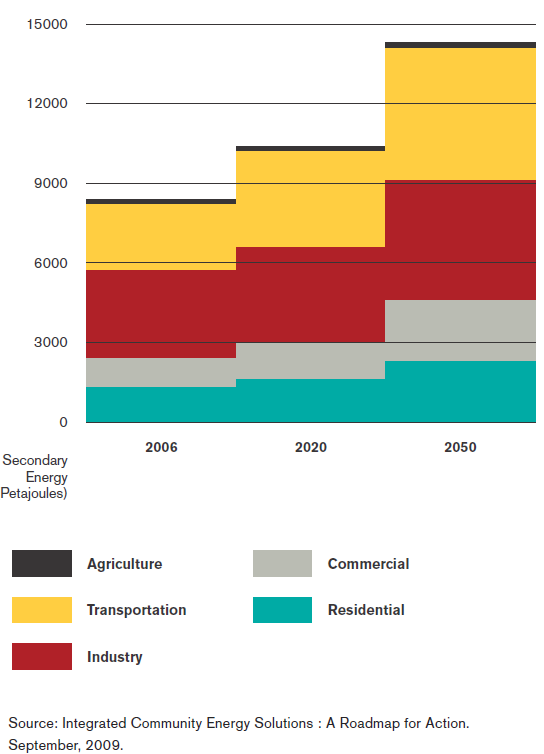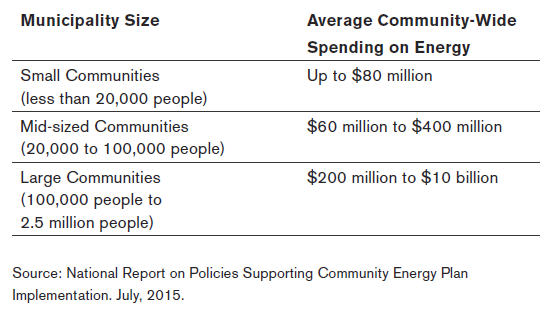Blog
Smart Energy Solutions: A Means to Ensure Widespread Energy Policy Adoption
While it might seem simple enough to get in place progressive policies to reduce energy use and greenhouse gases (GHGs) for the built environment, ensuring widespread uptake and adoption remains a critical challenge, if not a major market hindrance even when the right economic signals are being sent, such as with carbon pricing. Helping overcome this challenge will require the use of Smart Energy Solutions which are technological and fuel innovations that take advantage of opportunities to improve energy efficiency beyond individual buildings to encompass whole communities.

The Magnitude of the Climate Change Challenge When It Comes to Existing Buildings

In the case of buildings, the magnitude of the challenge that we are trying to tackle is immense. Across Canada, there
In communities, the heating, cooling and powering of buildings accounts for about 30
Shifting the level of current energy use in buildings and their associated GHG emissions is not a simple task. A significant portion of the 14.5 million structures (where 36 million of us live and work) are over half a century old5 6. As well, the operating life of most energy equipment in a home or a building can be anywhere from 10 to twenty-five years or more7 8.
As result, most of what we were going to build has been built, which results in a sizeable established building stock, and billions invested across the country in capital costs for the heating, cooling and powering of buildings that are still being recouped.

Addressing Our Existing Energy Building Use Footprint

Across Canada, we have started to address our built environment challenge head-on through federally innovative tools, such as EnerGuide, ENERGY STAR, the former ecoEnergy program, and model building codes, as well as industry voluntary approaches like the the Leadership in Energy and Environmental Design (LEED), BOMA Go Green, and through a host of provincial and utility programs, such as Save On Energy in Ontario, Power Smart in Manitoba, and the establishment of the first energy efficiency utility, Efficiency Nova Scotia.
These types of programs, codes and initiatives have had a positive impact including the reduction of GHGs; however, energy use in buildings across Canada has continued to increase. Over the last 10 to 15 years, energy use has increased between 6.5 to 20 percent9. In one business-as-usual scenario, community energy for buildings and transportation could be expected to increase by as much as 75 percent by 2050. It is anticipated that while GHGs will likely decrease, total energy use will go up.
Potential Growth of Energy Use in Canadian Communities


The Potential Cost of Not Putting Energy Efficiency First

When examining the potential increase in energy use against energy costs, we begin to think differently too, and the importance of energy efficiency first.
Energy is a significant and growing cost in Canadian communities with millions to billions of dollars being spent on energy each year. The table below outlines the range of average community-wide energy spending across communities of different sizes. On a per capita basis, this ranges from $2,000 to $4,000 per year10.
Typical Energy Spending in Small, Medium and Large Scale Communities
In 2013, $195 billion was spent on energy for heating, cooling, and transportation11. To put that in perspective, $1.6 billion was spent on energy in the City of London, Ontario in 2013 for all forms of heating, cooling, power and transportation (about $2500 to $4000 per capita). Some communities, such as in London, are anticipating cost increases of anywhere from 30-50 percent in the next fifteen years12.

Responding with Smart Energy Solutions

With anticipated increases in energy use and costs ahead, keeping the objective of reducing GHGs front and centre is essential, but encouraging an integrated approach that can help reduce energy end use and energy costs, is just as equally important.
At QUEST, we are committed to advancing Smart Energy Solutions, which are technological and fuel innovations that take advantage of opportunities to improve energy efficiency beyond individual buildings to encompass whole communities.
Traditional energy planning involves matching energy demand once development is finalized. As a result, energy systems are designed and developed after energy needs, such as for heating, cooling, and power for buildings new and existing, have been established, leaving little opportunity to reduce the need for energy in the first place.
QUEST is championing the reverse of this approach through the development of Smart Energy Communities, where decisions related to land-use planning, infrastructure for water and wastewater, waste management, personal mobility, goods movement, and building energy use for new and existing buildings are considered upfront and become opportunities to reduce energy use and to integrate and enhance the efficient use of energy at the community level from the outset.
For instance, a QUEST led Working Group in Ontario examined the potential to offset peak electricity demands with large central generation with combined heat and power (CHP), which would better match the heating, cooling and power needs of existing buildings, where they need it the most, locally. The result is Ontario could significantly reduce the reliance on
Across Canada, QUEST is involved in helping to convene governments, utilities and energy service providers, the real-estate sector (owners, operators, and builders), the product and professional services sector, among others, to learn from one another, evaluate solutions and to implement Smart Energy Solutions through outcome focused working groups. As a result, communities from coast to coast are exploring opportunities to drive down energy use in existing buildings through with the application of clean growth technology applications.
To learn about what QUEST is doing to address the challenge of increasing energy end use and costs, join us at our national conference and tradeshow – Smart Energy Communities on the Hill – November 6-8 at the Delta Ottawa City Centre.
References
[1] Statistics Canada. 2017. 2016 Type of Dwelling. Statistics Canada Catalogue no.
98-400-X2016017. Ottawa, Ontario. May 3. https://goo.gl/vf5Vod (accessed October 5, 2017)
2 Statistics Canada. 2016. Survey of Commercial and Institutional Energy Use, 2014. Statistics Canada Catalogue no. 11-001-X. Ottawa, Ontario. September 16. http://www.statcan.gc.ca/daily-quotidien/160916/dq160916c-eng.pdf (accessed October 5, 2017)
3 Natural Resources Canada. 2017. Canada’s Secondary Energy Use by Sector, End Use and Subsector, 2014. Retrieved from https://oee.nrcan.gc.ca/corporate/statistics/neud/dpa/showTable.cfm?type=HB§or=aaa&juris=ca&rn=2&page=0
4 Government of Canada. 2017. Pan-Canadian Framework on Clean Growth and Climate Change. Retrieved at https://www.canada.ca/content/dam/themes/environment/documents/weather1/20170125-en.pdf
5 Natural Resources Canada. 2014. Survey of Household Energy Use 2011. Retrieved from http://oee.nrcan.gc.ca/publications/statistics/sheu/2011/pdf/sheu2011.pdf
6 Natural Resources Canada. 2013. Survey of Commercial and Institutional Energy Use: Buildings 2009. Retrieved from http://oee.nrcan.gc.ca/publications/statistics/scieu/2009/pdf/scieu2009.pdf
7 ASHRAE. n.d. ASHRAE Equipment Life Expectancy chart. Retrieved from http://www.f22designs.com/cullum/wp-content/uploads/2013/02/ASHRAE_Chart_HVAC_Life_Expectancy%201.pdf
8 Consortium for Energy Efficiency. 2015. Residential Heating and Cooling Systems. Retrieved from https://library.cee1.org/sites/default/files/library/12006/CEE_ResidentialHeatingAndCoolingSystemsInitiative_May2015.pdf
9 Natural Resources Canada. 2017. Energy Fact Book 2016-2017. Retrieved from https://www.nrcan.gc.ca/sites/www.nrcan.gc.ca/files/energy/pdf/EnergyFactBook_2016_17_En.pdf
10 Community Energy Planning – A Competitive Advantage for Ontario – include footnote. https://questcanada.org/files/download/ff5cd870c543cdd
11 Natural Resources Canada. 2016. Energy Efficiency Trends in Canada 1990 to 2013. Retrieved at https://www.nrcan.gc.ca/sites/www.nrcan.gc.ca/files/energy/pdf/trends2013.pdf
12 QUEST. 2016. Community Energy Planning – A Competitive Advantage for Ontario. Retrieved from https://questcanada.org/files/download/ff5cd870c543cdd
Sign Up
Join the Conversation!
Sign up to get the latest news and updates about QUEST Canada events and receive QUEST Canada's monthly newsletter.


